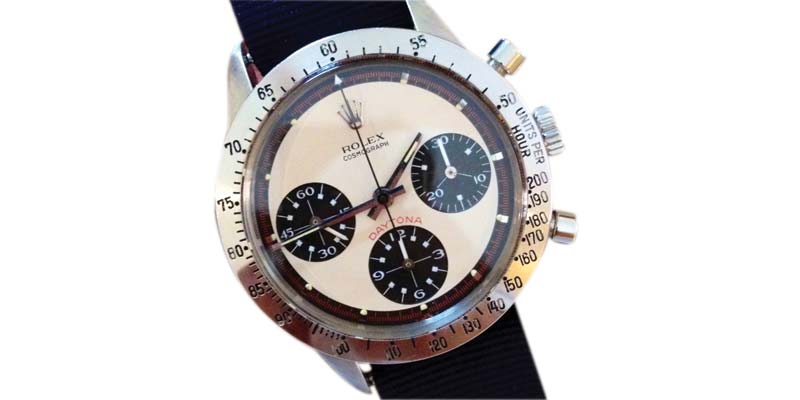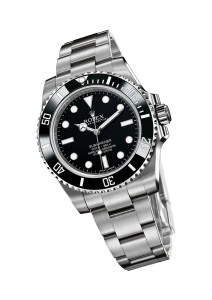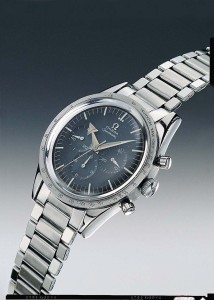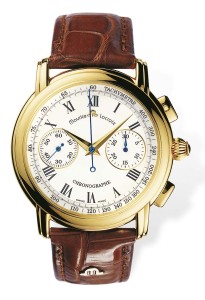Vintage and pre-owned watches: a niche that can pay big dividends
by charlene_voisin | May 1, 2013 9:00 am
By Nicole MacIntyre
 [1]
[1]Back in the late 1960s, a young man travelling through Europe decided to treat himself with a luxury watch. He paid roughly $600 for the Rolex Oyster Cosmograph Daytona.
More than 30 years later, he brought the so-called ‘Paul Newman’ to Greg Aron of Toronto’s Knightsbridge Jewellery. It’s modern day worth? $100,000.
Aron, who specializes in vintage timepieces, bought the rare stainless steel mechanical chronograph and went on to sell it for $110,000, proving the extraordinary potential and unprecedented risk in the vintage luxury watch industry.
“It’s a big market,” says Aron, who learned the trade from his father. “In the past 10 years, it has gone crazy.”
Trade in and trade up
 [2]
[2]The uncertain economy has made pre-owned watches—both vintage and newer used pieces—more popular than ever with clients looking for a safe place to invest or the chance to own a luxury piece with a more affordable price tag. Despite the increasing demand, the number of retailers willing to buy and sell vintage and pre-owned timepieces remains small in Canada. Many are scared off by the high upfront costs, threat of fakes, cost of refurbishment, and need for detailed knowledge about the watch industry, past and present. But for those willing to invest the time and money in used high-end watches, the payoff can be huge.
A few years ago Frank Damiani, owner of Damiani Jewellers in Woodbridge, Ont., wouldn’t have even considered buying a client’s old watch. He felt the same way about the cash-for-gold business. Then a customer asked him to send her jewellery along with his unsold gold to the refinery. Slowly, he started to offer the service more and more, much to his customers’ appreciation. When a client asked if Damiani would take an old Rolex, he saw another opportunity and took a chance. Now he sells two to three second-hand watches a month. While Damiani says taking in and selling pre-owned watches represents a tiny portion of his business, he adds a vintage piece can offer 20 to 30 per cent margins that can bring in $1000 or more in profits.
“I have a lot of my customers coming in with Rolexes,” Damiani explains, himself an authorized Rolex dealer. “These watches still have a lot of life in them.”
In fact, it’s not unusual for a client to come in with a watch they’d only just purchased a few months prior. Once on display, they rarely last more than a few weeks. “My customers love these watches because they can be had for half the retail price,” he adds. While Damiani says he has bought a few Cartier and Omega gold watches in the past, he tends to stick with Rolex. “It is where I have expertise and the parts to restore them.”
 [3]
[3]After checking the Rolex database to ensure a watch isn’t stolen, Damiani refurbishes it in-house to make it “like new again.” He often benefits from both ends of the deal, using his purchase of a watch as an incentive for a client to buy something else.
The impact of fashion on the watch industry means customers are often eager to change up their timepiece, a marked difference from decades ago. “In the old days, you bought a (wristwatch) for the rest of your life,” he says.
Sean Polan, a 30-year veteran of the watch industry and owner of distribution company, Sothil Inc., explains there are essentially two types of clients in the pre-owned watch market. On one end is the customer who wants the prestige of owning a luxury watch, but can’t afford to buy a new timepiece. For a few thousand dollars, they can own an impressive watch they can later sell and upgrade as they progress in life, he says. And in many cases, the watch is in perfect condition, adds Polan. “You’re almost buying it new.”
There is also the collector buyer, who is looking for a unique piece and is willing to pay a hefty premium to own it. Aron groups dealers in the same category, noting the Internet and availability of pricing have essentially melded the two. Collectors are often willing to pay in the tens of thousands for a watch, he explains.
Ironically, it is the poor sellers from decades ago that are the most sought-after today, since they were sold in smaller numbers. Popular watches made with high-end metals don’t fetch nearly as much as some stainless steel models that were considered failures when first introduced in the 1960s and ’70s. Limited editions are also in demand, being traded almost like rare baseball cards. Aron says he is willing to buy both older and newer pre-owned watches, although he tries to sell those ones immediately, keeping the vintage models for collector customers.
Proceed with caution
 [4]
[4]Though Rolex is a popular brand for vintage or pre-owned watches, there is also demand for other high-end names, such as Patek Philippe, Audemars Piguet, and even Omega.
If a retailer wants to take advantage of the pre-owned luxury watch market, experts say they should proceed cautiously. “You need to know watches and you need to have the customers for it,” says Polan. “You’ve got to become an expert. Those who do can make good money at it.”
The biggest risk in pre-owned or vintage watches is the amount of money a retailer needs to put out upfront, says Aron. If you make the wrong pick, there’s no supplier to take back unsold merchandise, he says. Even less expensive watches, including newer trade-ins in the low thousands, can mean a substantial upfront cost for retailers.
“Retailers are scared because they don’t want to make a mistake,” says Aron, noting the sweet spot for pre-owned watches is in the $2500- to $7000-range.
It can also be a challenge to get watches fixed affordably in Canada, he notes, even for newer watches. For instance, Rolex does not sell parts to unauthorized dealers, instead requiring retailers to send in watches to be refurbished. For older pieces, like the ‘Paul Newman,’ however, Rolex can refuse to service it, due to liability issues in opening the case or authenticating a piece that may later be sold at auction. However, Aron says he has been able to make relationships with suppliers to get parts himself.
 [5]
[5]Since vintage pieces have increased in value, the foreign counterfeit business has flourished. In some cases, it can be virtually impossible to tell a fake from an authentic piece, Aron says. Given the threat, he says many collectors want to be able to trace a watch’s ownership back to its original purchaser. A box and papers are not always enough, he explains, adding he has asked clients to supply old photos of them wearing a watch to prove its authenticity. “Collectors go nuts for that type of thing.”
Aron recommends retailers reach out to watch experts to help navigate their sales and ensure they are buying an authentic watch at a fair price. One of the worst mistakes a retailer can make is offending a customer by making a low offer for a valuable timepiece, especially when he or she can easily look up the value online. “It’s a formula and everyone has Google,” he says, warning retailers to avoid reducing themselves to the likes of a pawn shop. “If you do that to someone who has been a client for 20 years, he’s going to walk.”
Building relationships with customers is especially important in vintage watches because it tends to be the same clients who sell and buy watches repeatedly, he notes.
If a retailer invests the time in learning about this segment of the market, there is great potential for new customers, adds Polan. He’s watched the industry blossom and expects the trend to continue.
“I think it’s an industry that’s only going to grow.”
Nicole MacIntyre is a journalist and freelance writer based in Burlington, Ont. She has covered breaking news, politics, and lifestyle issues for nearly a decade. MacIntyre has received multiple nominations and awards for her work, including an Ontario Newspaper Award.
- [Image]: http://www.jewellerybusiness.com/wp-content/uploads/2015/12/Paul-Newman.jpg
- [Image]: http://www.jewellerybusiness.com/wp-content/uploads/2015/12/2_Submariner.jpg
- [Image]: http://www.jewellerybusiness.com/wp-content/uploads/2015/12/first-speedmaster-1957_alt.jpg
- [Image]: http://www.jewellerybusiness.com/wp-content/uploads/2015/12/IMG_1248.jpg
- [Image]: http://www.jewellerybusiness.com/wp-content/uploads/2015/12/Valjoux23.jpg
Source URL: https://www.jewellerybusiness.com/features/vintage-and-pre-owned-watches-a-niche-that-can-pay-big-dividends/